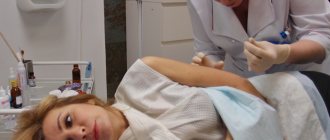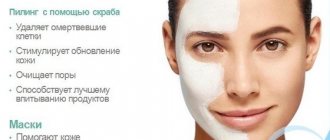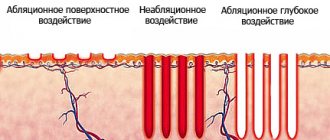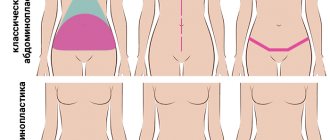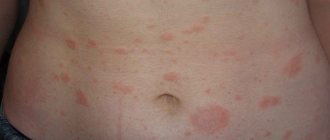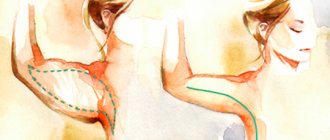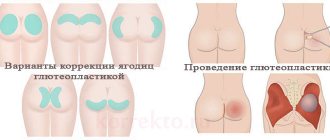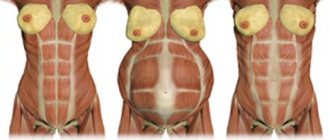Types depending on the location of the cuts
- Peri-umbilical (periumbilical).
Two parallel incisions are made symmetrically on both sides of the navel. It is used in cases where you need to remove stretch marks and tighten sagging skin in the area around the navel.
- Bikini line cut.
The most common method, which is most often used in women after cesarean section, when it is necessary to simultaneously eliminate an unsightly scar, tighten the skin, eliminate diastasis or muscle laxity, or repair a hernia.
- Accompanied by de-epidermization of the skin.
We can say that this is not a cut at all. The surface keratinizing layer is removed from the skin area and the excess skin is folded into a thin fold. It is used only when the excess skin is insignificant.
Mini abdominoplasty
Excess fat deposits and stretched skin in the abdominal area create a serious problem for a person, causing him psychological discomfort and forcing him to hide the flaws of his body behind shapeless, bulky clothes. Today there is a quick and effective solution to the problem - mini tummy tuck or mini abdominoplasty. This operation is a surgical procedure that tightens loose skin in the lower abdomen while removing excess fat tissue.
Free annual maintenance and monitoring!
After surgery, we provide our patients with free annual care, monitoring and support from surgeons and clinic staff on all issues related to your plastic surgery.
Installment plans are possible
*. For details, call the clinic.
Prices
- Mini abdominoplasty
- Badak O.E., Filippov A.I., Kopasov A.E., Kondratyev D.G., Naydenov N.P.
180 000 ₽
- Tumakov G.I., Egorova M.V., Abramyan S.M.
260 000 ₽
- Full abdominoplasty
- Badak O.E., Filippov A.I., Kopasov A.E., Kondratyev D.G., Naydenov N.P.
260 000 ₽
- Tumakov G.I., Egorova M.V., Abramyan S.M.
360 000 ₽
Prices for surgery from professors S.N. Blokhin and Wolf I.A. - on request.
All inclusive!
- Consultation with an anesthesiologist
- Anesthesia
- Hospital stay (room + meals)
- Complete post-operative care
- Free annual maintenance (monitoring and support on all issues related to the operation)
One of the great advantages of mini abdominoplasty is its minimal invasiveness. Sometimes they say that this operation does not leave any marks or scars on the body, but this is a misconception. It's all about comparison with classic tummy tuck: with a mini tummy tuck, an incision is made in the bikini area above the pubic bone. It is horizontal, does not affect the navel and is much shorter than with a full abdominoplasty.
During a face-to-face consultation with a surgeon, a choice of surgical technique is made - mini abdominoplasty or full abdominoplasty - depending on the indications.
Mini abdominoplasty is indicated for those patients who have excess fat and skin only in the area below the navel. Both full abdominoplasty and mini tummy tuck work well with liposuction and are often used after liposuction to remove excess, sagging skin. Both of these operations are performed under general anesthesia. Mini abdominoplasty usually takes no more than 2 hours.
Abdominoplasty or COOLSCULPTING?
Before and after
All photos
Video
Result of mini-abdominoplasty (mini-tummy tuck)
Who is suitable for mini-dominoplasty?
If you want to:
- emphasize the waist,
- get rid of stretch marks, sagging skin,
- eliminate excess fatty tissue in the lower abdomen,
in these cases, it makes sense to contact a surgeon for mini-abdominoplasty. If you have previously suffered from any diseases or are predisposed to them, then you should first discuss this issue with your surgeon. Women planning a pregnancy in the near future should wait and seek abdominoplasty after childbirth.
Mini abdominoplasty is great for removing stubborn fat that hasn't gone away after dieting and regular exercise, as well as removing excess skin left after major weight loss or pregnancy. But do not confuse abdominoplasty with weight loss procedures. For many people, liposuction may be the first choice.
How long will the rehabilitation period take after mini abdominoplasty?
After the operation, the patient spends 1-2 days in the hospital. It usually takes about 2 days for the pain to go away, which is easily relieved with analgesics. Also, in the first days after the operation, there will be drainage tubes in the lower abdomen. Swelling, bruising and discomfort after a mini tummy tuck may remain for several weeks. Most people can return to their normal lifestyle within 2 weeks after surgery. In the first month, you should stop doing physical exercises, and you will also need to wear compression garments. The final result can be assessed six months after the operation.
Dear patients!
At the same time as any plastic surgery, you can remove a hernia of any etiology (inguinal, umbilical)!
What options are possible depending on the volume of the operation?
- With the removal of excess skin.
It is usually used when the patient has excess skin and subcutaneous fat in the area below the navel.
- With suturing of muscles.
If, in addition to excess skin and adipose tissue, there is a separation of the rectus abdominis muscles or weakness of the abdominal muscles, which was initially present as a constitutional feature, or as an acquired pathology, more often after pregnancy.
- No navel movement.
If it is necessary to tighten the skin below the level of the navel and a short distance above the level of the navel, then the skin is stretched so that the navel moves slightly downward and remains at this new level. The navel is not moved to its previous level, as is done with classic abdominoplasty, but the tissue will not be stretched too much either. Therefore, this option is not suitable for everyone.
- With liposuction.
It is often performed on those whose abdominal skin is not elastic enough to perform liposuction on their own. If the tone of the abdominal muscles is reduced, there is diastasis or hernias, then muscle suturing, liposuction and removal of excess skin are performed during one operation. If muscle tone is normal, then mini-abdominoplasty is performed without suturing the muscles with liposuction.
Types of tummy tuck
Abdominoplasty (miniabdominoplasty) is classified according to the location where the incision is made in the patient's skin:
- Periumbilical miniabdominoplasty. The second name of the operation is peri-umbilical abdominoplasty. This method of surgical correction is indicated for patients who have stretch marks and sagging skin. By making parallel incisions in the skin on either side of the belly button, the plastic surgeon can tighten the skin and eliminate stretch marks.
- Mini abdominoplasty with an incision along the bikini line. This surgical method is indicated for women who have had a caesarean section. Using an incision along the bikini, a plastic surgeon can remove rough scars from surgery, tighten the skin, and also repair abdominal muscle separation and repair an umbilical hernia.
- Mini abdominoplasty with skin de-epidermization. This method of surgical tummy tuck is indicated only for those patients who have mild excess skin in the lower abdomen. During the operation, the doctor removes the keratinized layer of skin and uses an excess skin flap to form a thin fold.
Miniabdominoplasty is also divided into several subtypes of operations depending on the scope of correction:
- Mini abdominoplasty with removal of excess skin. During the tummy tuck procedure, the plastic surgeon removes the skin apron and also excises excess subcutaneous fat in the lower abdomen.
- Mini abdominoplasty with muscle suturing. The main indication for mini-abdominoplasty with muscle suturing is weakness of the abdominal wall or muscle separation. This problem can be either an anatomical feature of the patient or a consequence of carrying a child during pregnancy.
- Mini abdominoplasty without moving the navel. Mini abdominoplasty without navel relocation is performed on patients who do not require a volumetric lift in the lower or upper abdomen. However, it should be remembered that during the process of skin tension, the navel may move a couple of cm, so this type of mini-abdominoplasty is not suitable for all patients.
- Mini abdominoplasty with liposuction. Plastic surgery is performed on patients who have decreased tone of the abdominal wall muscles or their discrepancy. A complex operation is indicated in the presence of an umbilical hernia: the plastic surgeon performs skin tightening, muscle suturing and liposuction in one procedure.
Photos taken before and after mini-abdominoplasty allow you to evaluate the results of the operation aimed at tummy tuck.
Contraindications
the patient has not reached the age of majority;- infectious diseases (malaria, tuberculosis, colds, STIs, etc.);
- the presence of acute diseases of internal organs, recent injuries;
- the presence of chronic diseases that led to the development of organ failure (renal, liver failure);
- diseases of the cardiovascular system (severe arterial hypertension, frequent crises, cardiac arrhythmias, heart failure);
- endocrine diseases (type 1 diabetes, decompensated type 2 diabetes);
- benign and malignant diseases;
- skin diseases of any etiology (fungi, bacteria, viruses);
- inflammatory and purulent diseases of the skin and subcutaneous tissue;
- any foci of purulent infection in the body (sinuses, middle ear, tonsils, rotten carious teeth, etc.).
How is the operation performed?
The operation takes up to two hours. It is performed only under general anesthesia. Before the operation, it is mandatory to apply markings that determine the amount of tissue to be removed, the symmetry of the incisions and other things necessary for an excellent result.
In the operating room, the patient is given anesthesia, which can be intravenous or inhalational, the skin in the surgical area is treated with antiseptics, and the remaining areas are covered with sterile napkins and sheets. A scalpel can be used to make cuts, but more often they use an electrocoagulator, which simultaneously cuts tissue and seals small and medium-sized vessels.
Therefore, the operation takes place with less blood loss and its duration is reduced by reducing the time that the surgeon spends on hemostasis at the end of the operation, i.e. to stop bleeding from the vessels of the surgical wound.
If suturing muscles or reducing hernias is planned, this is done first. Liposuction is performed secondarily if it has been planned. The third stage removes excess skin and subcutaneous fat in the lower abdomen. The tissues are stretched so that the edges of the wound meet and stitched together. The postoperative wound can be sutured with either non-absorbable suture material or absorbable threads.
After the sutures are applied, the postoperative wound is treated with antiseptics and covered with a sterile bandage. Already in the operating room, the patient is wearing compression garments.
Find out what methods a butt lift is performed and what you can do to bring your body closer to ideal parameters.
Body-Jet liposuction is performed using a device manufactured by the German company Human Med AG. Read more at the link.
Progress of the operation
Before surgery, the doctor outlines the contour, determines the amount of fat that needs to be removed and the degree of complexity of the work ahead. In most cases, general anesthesia is used, but local anesthesia is not excluded. Miniabdominoplasty involves the following: during the operation, only a small area of the abdomen is affected; the incision itself is much smaller than with an extensive abdominoplasty.
The plastic surgeon makes an incision with a regular scalpel or a laser, which closes the vessels, then, if there is a problem with hernias, he reduces them. After eliminating this problem, liposuction is performed, and then excision of fatty tissue and excess skin.
Upon completion of the work, the surgeon stretches the skin over the edges of the intervention area and applies sutures, the treatment area is treated with an antiseptic and a bandage is applied.
Consequences
- Edema.
This is normal for such operations. The swelling begins to increase almost immediately after the end of the operation, and it goes away within a month to three months. It is after the swelling goes down that the results of the operation can be assessed.
- Hematomas.
May have varying degrees of severity. Subcutaneous hematomas can be frighteningly blue, almost black, and spread over large areas of the skin. But even such diffuse bruises disappear within the first two months without a trace.
- Pain.
The larger the volume of the operation, the more pronounced the pain may be in the postoperative period. Usually the pain lasts no more than a week or two after surgery and is well relieved by taking painkillers.
- Strong tension of the skin on the abdomen.
This is something you will have to put up with for the first month or two. The skin tension is so strong that in some cases the patient has to walk hunched over before the sutures are removed and for some time afterwards. Gradually, as the seam heals and a scar forms, you can straighten more and more.
Video: How is tummy tuck performed?
Recovery period
- Staying in hospital.
After a mini tummy tuck, the patient will have to stay in the hospital from two to three days to a week. On the first day you can only lie down. With the doctor's permission, the medical staff can raise the head end of the bed so that the patient is reclining in the bed.
If there is no nausea and vomiting, then a couple of hours after the operation you can drink any water except carbonated water. In the evening, if your health allows, a light dinner is allowed. On the second and subsequent days, you are allowed to sit up in bed with the help of medical staff, and then get out of bed and start walking.
- Restoration of working capacity.
After discharge from the hospital, you will have to spend another two weeks at home, since you may not feel well enough to go to work, as well as pain when standing up, walking, or doing simple household chores.
- Compression underwear.
The bandage will need to be worn for at least a month after surgery. You can completely or partially refuse to wear compression garments in consultation with the operating doctor.
- Seams.
The sutures are removed at 10-14 days. All the time until the stitches are removed, they need to be treated with antiseptic solutions. The stitches should not be wet for the first five days. This means no showers or baths. Within three to four weeks after surgery, the suture may bulge and even bunch up. Usually these are the consequences of swelling and you can expect that after the swelling subsides, the seam will smooth out.
- Limitations and recommendations.
In the first month, it is not recommended to be exposed to any influences that may increase swelling:
- You cannot massage the sutures, or generally the lower and middle third of the abdomen, or rub in creams and ointments;
- You should avoid thermal procedures, exposure to any heat on the area of the operation (heating pad, heat from a fireplace or stove, sauna and bathhouse).
The area where the scar is located should be hidden from the sun or light from solarium lamps for 12 months so as not to provoke pigmentation of the scar.
- Sports and physical activity.
Limiting physical activity and sports for 3 months. You can then gradually return to exercise, starting with light exercises without stress on the abdominals for at least another 3 months.
Video: Doctors about abdominoplasty
Rehabilitation after mini abdominoplasty
In the initial rehabilitation period, the patient wears a bandage or compression garments. Recovery time for miniabdominoplasty is short; sometimes the patient is sent home the very next day after surgery. The rehabilitation period is 7-14 days. It is recommended to take a vacation during this time.
It's not just that you need to exert less physical effort. It is necessary to give the body the opportunity to fully activate its recovery resources.
Any operation, including mini-abdominoplasty, is stressful not only for the internal tissues in the area of surgical intervention, but also for general processes in the body: immune, metabolic.
You can, of course, force yourself to go to work. But general weakness and discomfort are clear signals that the body needs to be given the opportunity to recover. A calm lifestyle and a healthy diet during the rehabilitation period after mini-abdominoplasty will give results much faster, and in the future it will pay off handsomely.
By the way, about nutrition. Abdominoplasty does not affect the internal organs of the abdominal area. At the same time, during the recovery period it is worth paying close attention to your diet. It is necessary to exclude salty, spicy, fried foods. For the first two weeks, it is better to eat light food. Anything that complicates the digestion process (fatty meat, legumes) simultaneously causes blood flow to the abdominal cavity, and this is extremely undesirable after mini-abdominoplasty.
Restrictions also apply to physical activity. If you play sports, you will have to take a break for about 2 months. The same applies to any weight lifting.
All scars after miniabdominoplasty finally resolve after about six months.
Of course, external manifestations disappear much earlier, but physiologically the scarring process lasts about 6 months. During this time, you need to come to the doctor several times for a preventive examination.
In Moscow, many plastic surgery clinics perform miniabdominoplasty. To ensure that the operation is carried out at a professional level, carefully choose a medical institution and specialist. You should pay attention to the reputation of the clinic and reviews about it, the experience, work of the doctor in mini-abdominoplasty, his specialization in surgery.
In our clinic in Moscow, miniabdominoplasty is performed regularly by experienced specialists with extensive professional experience. Visit for a free consultation and find out about the possibilities of tummy tuck in your case!
Video
Example of mini abdominoplasty
Cost of mini abdominoplasty
| Name | Price |
| Excision of the abdominal fold due to deformation of its lower part (miniabdominoplasty) category 1 | 120,000 rub. |
| Excision of the abdominal fold due to deformation of its lower part (miniabdominoplasty) category 2 | 140,000 rub. |
| Primary appointment (examination, consultation) with a plastic surgeon | FOR FREE |
Complications
- Lack of expected effect.
It may be the result of the doctor’s crookedness, or it may be a consequence of the patient’s inadequate assessment of her own body. The photo shows the result of abdominoplasty and thigh liposuction.
None of the surgeons who consulted and operated advised the woman to lose weight, despite the fact that the woman was clearly obese, grade 3-4.
And this weight is precisely a contraindication for both liposuction and abdominoplasty. Another option for the patient’s appearance after miniabdominoplasty and liposuction. The result is far from ideal.
- Seams coming apart.
It may be a consequence of suppuration of the sutures, significant stress on the abdominal muscles, circulatory problems due to significant tension of the skin on both sides of the surgical wound. The photo shows a case of suppuration of a postoperative wound when its healing is impaired.
In either case, surgery is required to bring the edges of the wound back together and stitch them together.
- Necrosis (death) of parts of the skin that form a postoperative scar.
Local necrosis may occur, as in the photo below, which may require removal of dead areas of the scar and suturing.
And here there is extensive necrosis of the entire thickness of the abdominal wall. Here the conversation is no longer about eliminating a cosmetic defect, but about saving the patient’s life and covering the area of dead tissue with flaps moved from neighboring areas of the body (side area, back).
- Formation of a roll of adipose tissue along the edge of the scar.
The thickness of the fat fold in different parts of the abdomen may be different, therefore, when removing excess skin and suturing the edges of the wound, a discrepancy in the thickness of the subcutaneous fat tissue may appear in the form of a protruding roller and a recess underneath it. Surgery is required to correct the defect.
What is electrolipolysis? How is the procedure performed, what complications, indications and contraindications may there be? Read all about it in the article - electrolipolysis.
Reviews of women who have tried lpg full body massage can be found at this address.
Liposonix technology is contraindicated in individuals suffering from certain medical conditions. Find out about it at the link.
